There is no doubt that robotic milking is a suitable solution for large dairies, as there are several examples of successful dairies working under different conditions around the world.
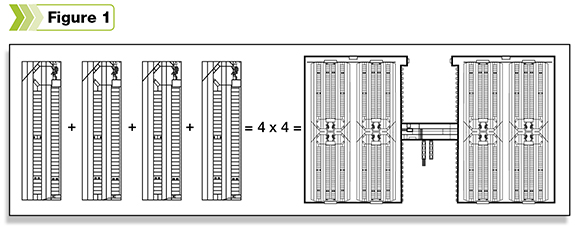
I say this not only because of my experience working with them and seeing how well they perform but because of robotic milking’s basic principle: scalability ( Figure 1 ).
Operating one automatic milking system (AMS) requires the same set of skills as operating multiple units.
At the end of the day, what happens in one pen with one or two robots, or at the biggest AMS facility in North America with 20 machines, is the same as what happens at the world’s largest AMS facility in Russia operating with 34 units.
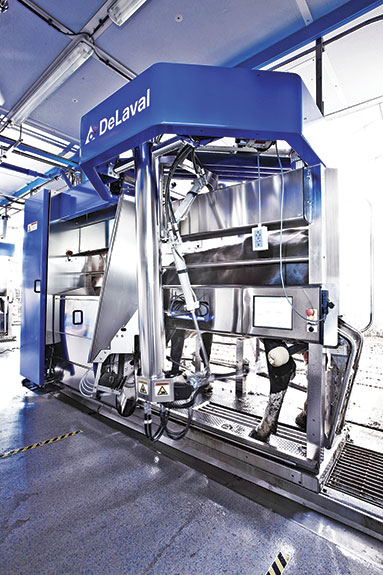
The difference between those operations is the varying levels of management expertise, which is no different compared to what happens in conventional milking systems (CMS).
When thinking of how to start a large-scale AMS project (eight or more robots milking at least 480 cows), this question always comes up: Should we go fully automated or start with a hybrid operation?
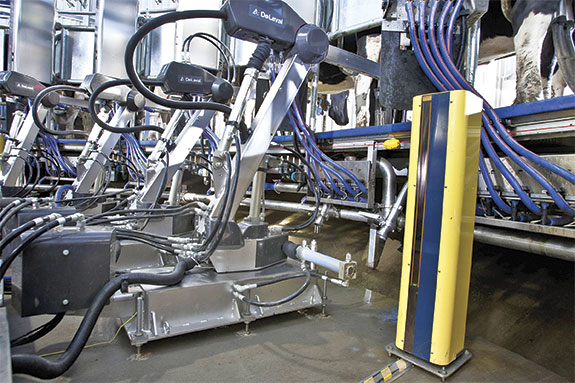
Most projects have started in phases, milking only part of the herd with AMS. This seems to be the most logical way to transition from a financial standpoint.
Across North America, the most common configurations to start with are 50 percent AMS and 50 percent CMS for farms milking up to 1,000 cows and 20 percent AMS and 80 percent CMS for larger dairies.
Due to principles like scalability, modularity and flexibility, large dairies can be retrofitted or built new; both are achievable when you put the cow first.
Benefits of AMS for large dairies
Large dairies can achieve the same benefits compared to small and medium-size dairies. However, there are two areas where robotic milking can have a greater impact on large dairies.
1. Labor
While technology costs go down, labor costs go up. This irreversible trend has affected most industries, and dairy is no exception. Automation will be the sustainable solution of the future.
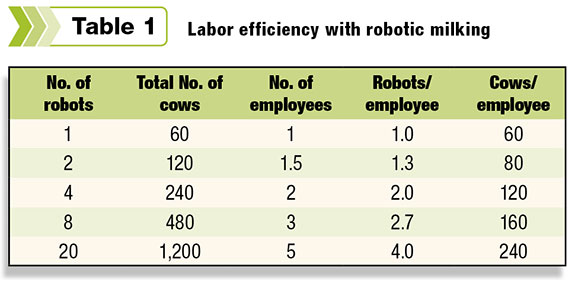
When considering robotic milking, it’s important to evaluate labor efficiency, which is the number of robots per employee.
Table 1 shows examples of different AMS farm sizes and the required number of employees under real North American conditions.
The labor issue is not only a matter of efficiency but availability.
The lack of qualified labor in our business is the result of failing to attract young, high-caliber individuals.
Hiring young, tech-savvy people and developing them into great herd managers is no doubt a big step. They will likely demand a higher salary, but the pay-off will come as they use the technology and data to make accurate decisions and effective management strategies.
2. Management by exception
The most ideal group size: one cow. Regardless of the operation’s scale, technologies included within the robot, or peripherally, let farmers focus on individual cows without losing the group management scope. Those individuals can be monitored and managed in a unique way to help drive profitability.
Planning a large AMS dairy
When making plans for a large-scale AMS facility, I recommend evaluating these key aspects:
Size
• Make a short-term, mid-term and long-term strategy plan to be implemented in phases.
• An ideal size to start the first phase would be eight robots – 480 cows with groups of 60 cows to one robot or 120 cows to two robots. Larger pens are possible, just make sure all considerations (especially cow flow) are included.
• Once the eight-robot barn is running and performing according to expectations, then you are ready for expansion. Remember to plan and build for future growth.
Cow comfort and cow handling
• Grouping animals in robotic barns should be based on lactation number and cow behavior, not on stage of lactation. When planning and making decisions, early lactation cows should take priority.
• Feeding is not only about ration quality but also ration availability. Offer 24 to 30 inches of feedbunk space per cow. Ideally plan for two or a maximum of three rows of freestalls per side of feedbunk. This can be achieved with either central or perimeter feeding.
• Sand bedding is the gold standard for large dairies. Plan bedding practices and design barns that facilitate good access and handling. If mattresses are the choice, then go for the best cushion, traction and support, together with wider alleys.
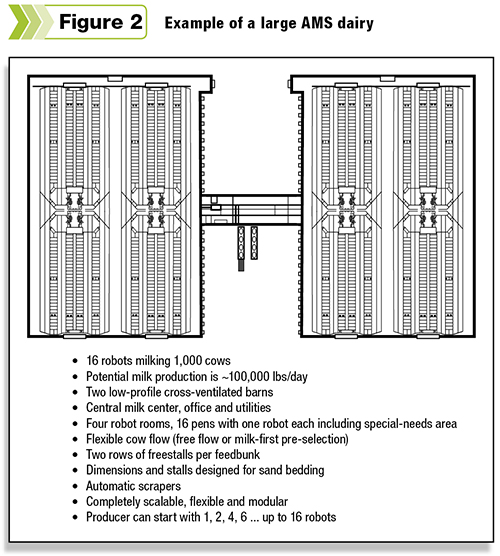 • Avoid overstocking, as it works against fresh cows. In practice, large robotic-milking dairies don’t go higher than 105 percent stocking density.
• Avoid overstocking, as it works against fresh cows. In practice, large robotic-milking dairies don’t go higher than 105 percent stocking density.
• One or multiple robots per pen are proven to work. Just make sure the layout allows one person to move cows to the robot or special-needs area without extra help.
• Continue with your current footbath practices. They will be crucial for hoof health, as cows need to be able to access the robot.
• I strongly recommend headlocks even with special-needs areas. Besides facilitating normal routines, it makes singeing udders easier.
• Either with natural or mechanical ventilation, it is important that cows distribute themselves evenly throughout the barn to avoid congestion or disruptions due to temperature variations.
Low-profile cross-ventilated barns offer great air and temperature distribution especially during summer months.
Cow traffic
• Feeding strategies: If TMR is your focus and you want to minimize pellet costs, milk first pre-selection is the way to go. If you find opportunities by customizing feeding plans and feeding 50 percent of grain pellets in the robots, then both free-flow and milk first pre-selection will work.
• Labor savings: From this perspective, the most efficient cow traffic is milk first pre-selection, as you will fetch around 3 percent of the cows, compared to 15 percent with free-flow.
For small and medium-size dairies, the difference is not as dramatic, but when milking 1,000 cows, the numbers can vary from 30 to 150 cows – a big difference.
• Simplicity: If you want to avoid smart gates and one-way gates, and can afford the extra cost of labor, free-flow should be your choice. setting expectations is the key to satisfaction.
Transition
Regardless of size, it is important to be aware that routines will change, as well as management style. Planning for an adjustment period is crucial.
Training your people, setting a strategy, having a strong team approach and choosing the right cows will drive you toward success.
Don’t forget to take advantage of the opportunity to select ideal cows for AMS based on:
• Milking speed
• Udder conformation, specifically teat position and teat size
• Lactation: Second-lactation cows offer a great combination of maturity and adaptation compared to first-lactation and third-lactation cows. Older cows adapt at a slower pace.
Single-stall robots and DeLaval AMR
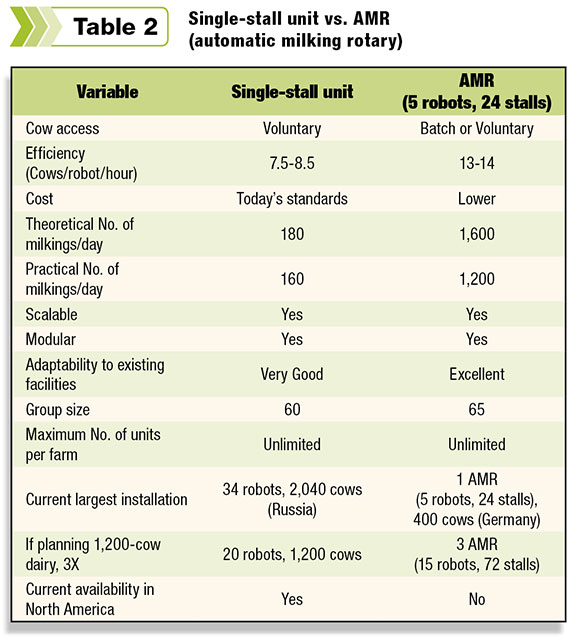
To date, the most popular system for large commercial dairies has been the single-stall unit. In 2010, DeLaval introduced the Automatic Milking Rotary (AMR).
AMR has been working at test farms since 2009 with a couple of commercial installations operating today in Germany and Tasmania.
AMR is not currently available in North America but expected to arrive in 2014. Both single-stall units and AMR are solutions with potential in the large-dairy segment.
The future of large-scale AMS is very promising. The introduction of efficient technologies is the best way to face the different challenges our industry needs to overcome.
Innovations will have the greatest impact from labor, herd management and social responsibility perspectives.
When considering robotic milking for your large herd, make sure you plan your work and work your plan – then the result won’t be anything but success. PD
Rodriguez is a veterinarian and works for DeLaval as an adviser for automated milking systems in North America.
PHOTOS
When thinking of how to start a large-scale AMS project (eight or more robots milking at least 480 cows), this question always comes up: “Should we go fully automated or start with a hybrid operation?”
TOP RIGHT: A single-stall robotic-milking unit.
MIDDLE RIGHT: An automatic milking rotary parlor. Photos courtesy of Francisco Rodriguez.

Francisco Rodriguez
Dairy Management Adviser
DeLaval





